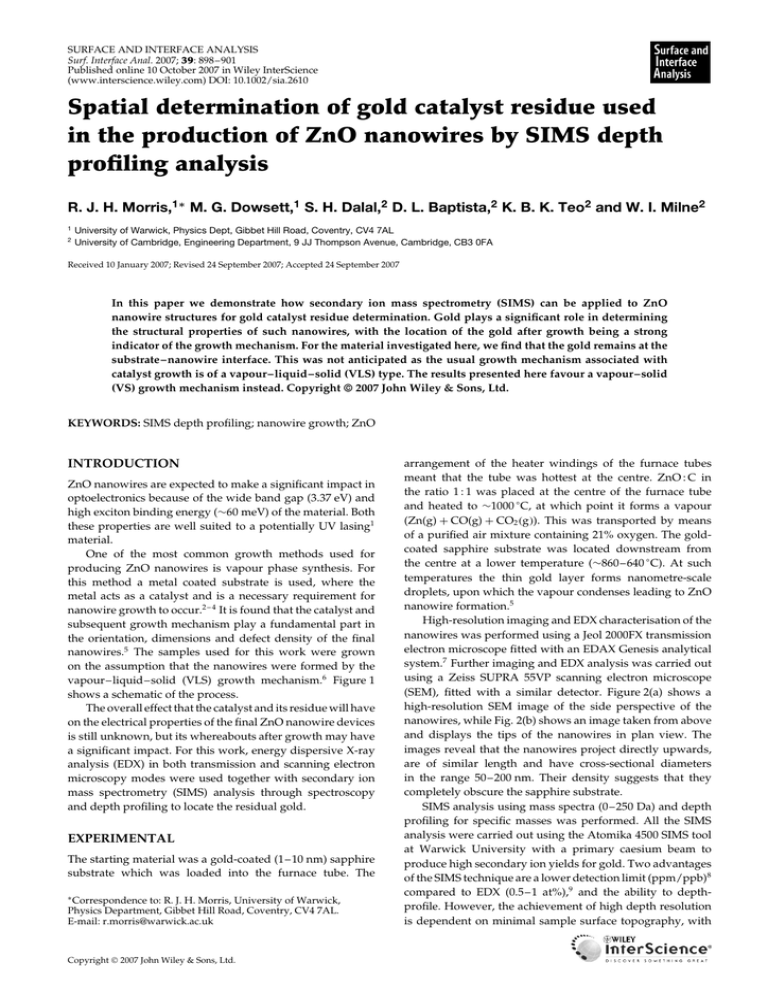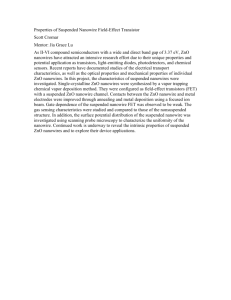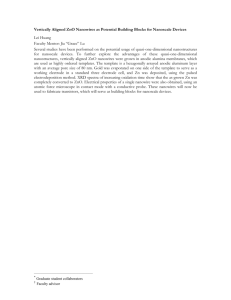Document 12871135
advertisement

SURFACE AND INTERFACE ANALYSIS Surf. Interface Anal. 2007; 39: 898–901 Published online 10 October 2007 in Wiley InterScience (www.interscience.wiley.com) DOI: 10.1002/sia.2610 Spatial determination of gold catalyst residue used in the production of ZnO nanowires by SIMS depth profiling analysis R. J. H. Morris,1∗ M. G. Dowsett,1 S. H. Dalal,2 D. L. Baptista,2 K. B. K. Teo2 and W. I. Milne2 1 2 University of Warwick, Physics Dept, Gibbet Hill Road, Coventry, CV4 7AL University of Cambridge, Engineering Department, 9 JJ Thompson Avenue, Cambridge, CB3 0FA Received 10 January 2007; Revised 24 September 2007; Accepted 24 September 2007 In this paper we demonstrate how secondary ion mass spectrometry (SIMS) can be applied to ZnO nanowire structures for gold catalyst residue determination. Gold plays a significant role in determining the structural properties of such nanowires, with the location of the gold after growth being a strong indicator of the growth mechanism. For the material investigated here, we find that the gold remains at the substrate–nanowire interface. This was not anticipated as the usual growth mechanism associated with catalyst growth is of a vapour–liquid–solid (VLS) type. The results presented here favour a vapour–solid (VS) growth mechanism instead. Copyright 2007 John Wiley & Sons, Ltd. KEYWORDS: SIMS depth profiling; nanowire growth; ZnO INTRODUCTION ZnO nanowires are expected to make a significant impact in optoelectronics because of the wide band gap (3.37 eV) and high exciton binding energy (¾60 meV) of the material. Both these properties are well suited to a potentially UV lasing1 material. One of the most common growth methods used for producing ZnO nanowires is vapour phase synthesis. For this method a metal coated substrate is used, where the metal acts as a catalyst and is a necessary requirement for nanowire growth to occur.2 – 4 It is found that the catalyst and subsequent growth mechanism play a fundamental part in the orientation, dimensions and defect density of the final nanowires.5 The samples used for this work were grown on the assumption that the nanowires were formed by the vapour–liquid–solid (VLS) growth mechanism.6 Figure 1 shows a schematic of the process. The overall effect that the catalyst and its residue will have on the electrical properties of the final ZnO nanowire devices is still unknown, but its whereabouts after growth may have a significant impact. For this work, energy dispersive X-ray analysis (EDX) in both transmission and scanning electron microscopy modes were used together with secondary ion mass spectrometry (SIMS) analysis through spectroscopy and depth profiling to locate the residual gold. EXPERIMENTAL The starting material was a gold-coated (1–10 nm) sapphire substrate which was loaded into the furnace tube. The Ł Correspondence to: R. J. H. Morris, University of Warwick, Physics Department, Gibbet Hill Road, Coventry, CV4 7AL. E-mail: r.morris@warwick.ac.uk Copyright 2007 John Wiley & Sons, Ltd. arrangement of the heater windings of the furnace tubes meant that the tube was hottest at the centre. ZnO : C in the ratio 1 : 1 was placed at the centre of the furnace tube and heated to ¾1000 ° C, at which point it forms a vapour (Zn(g) C CO(g) C CO2 g). This was transported by means of a purified air mixture containing 21% oxygen. The goldcoated sapphire substrate was located downstream from the centre at a lower temperature (¾860–640 ° C). At such temperatures the thin gold layer forms nanometre-scale droplets, upon which the vapour condenses leading to ZnO nanowire formation.5 High-resolution imaging and EDX characterisation of the nanowires was performed using a Jeol 2000FX transmission electron microscope fitted with an EDAX Genesis analytical system.7 Further imaging and EDX analysis was carried out using a Zeiss SUPRA 55VP scanning electron microscope (SEM), fitted with a similar detector. Figure 2(a) shows a high-resolution SEM image of the side perspective of the nanowires, while Fig. 2(b) shows an image taken from above and displays the tips of the nanowires in plan view. The images reveal that the nanowires project directly upwards, are of similar length and have cross-sectional diameters in the range 50–200 nm. Their density suggests that they completely obscure the sapphire substrate. SIMS analysis using mass spectra (0–250 Da) and depth profiling for specific masses was performed. All the SIMS analysis were carried out using the Atomika 4500 SIMS tool at Warwick University with a primary caesium beam to produce high secondary ion yields for gold. Two advantages of the SIMS technique are a lower detection limit (ppm/ppb)8 compared to EDX (0.5–1 at%),9 and the ability to depthprofile. However, the achievement of high depth resolution is dependent on minimal sample surface topography, with Spatial determination of gold catalyst residue by SIMS depth profiling (a) Metal catalyst film Substrate (b) Metal-substrate alloy nanoparticles Substrate (c) Zn(g)+CO(g)+CO2(g) Physisorption Substrate (d) Alloy tips Nanowires Substrate Figure 1. Schematic representation of the vapour–liquid–solid (VLS) growth mechanism for vapour phase synthesis nanowire production using a catalyst. (a) Metal catalyst coated starting substrate, (b) formation of catalyst-substrate nanoparticles upon heating, (c) introduction of vapour and (d) nanowire formation with some of the alloy remaining at the nanowire tips. surface topography clearly precludes high depth resolution, and it is also necessary to monitor the effects of sputtering on the nanowires to ensure that the general location of any signals can be reliably determined. SIMS spectra were acquired using 500 eV CsC at low current (5 nA) and at 50° to the surface normal. The diameter of the caesium beam was ¾100 µm and a large area (500 ð 500 µm) was analysed. Under these bombarding conditions a slow erosion rate is achieved, limiting the analysis to the near-surface region (with the nanowires blocking beam access to the substrate) while offering a larger number of nanowires to be sampled simultaneously. Individual mass spectra were taken from separate regions and also sequentially from the same region in order to obtain near-surface lateral and vertical information. In the case of the SIMS depth profiling analysis, the angle of incidence of the caesium beam was kept at 50° from normal but the energy and current were increased (1.5 keV, ¾25 nA). The area of analysis was reduced (250 µm ð 250 µm) to enhance the erosion rate. The masses profiled were 18 O, 27 Al and 197 Au. Oxygen was measured because it is one of the main nanowire constituents, while the obvious alternative, zinc, does not produce high negative secondary ion yields under caesium bombardment. The oxygen signal provided basic information about the matrix uniformity, while that of aluminium was monitored as an indicator for the nanowire–substrate interface. RESULTS AND DISCUSSION 1.5µm 1µm (a) (b) Figure 2. (a) SEM image of the ZnO nanowires’ side-on perspective and (b) an SEM image of the nanowire tips from above. the best depth resolution only achievable from an atomically flat surface. In the case of the nanowires analysed here, the Copyright 2007 John Wiley & Sons, Ltd. A distinctive characteristic of the VLS growth mechanism is that some of the catalyst remains at the tips of the nanowires during growth.10 In order to investigate this, ZnO nanowires were carefully parted from the sapphire substrate and placed onto a carbon-coated copper transmission electron microscope (TEM) grid. From high-resolution TEM imaging, no gold/gold alloy was observed for the many nanowires investigated (Fig. 3). EDX measurements were subsequently carried out along the lengths of numerous nanowires, both individually and simultaneously, with no gold emission observed. Further EDX analysis was performed using SEM. From SEM imaging, different regions of the sample were selected enabling as-grown nanowires, regions where the nanowires had been carefully removed for TEM analysis and SIMS sputtered craters to be analysed. Once again, no evidence of gold from any of the regions analysed was found. Figure 4 shows a typical EDX spectrum of the asgrown material, from which only the main constituents of the ZnO nanowires were observed: Zinc (L˛ : 1.012 keV, K˛ : 8.630 keV, Kˇ1: 9.570 keV), oxygen (K˛ : 0.532 keV) and carbon (K˛ : 0.284 keV). For EDX analysis performed in close proximity to the substrate and sputtered SIMS craters, an aluminium emission peak (K˛ : 1.486 keV) was also observed. If gold had been detected, its principal emission lines11 at 2.121 and 9.712 keV would have been evident. From EDX analysis performed on a piece of gold and a 5 nm gold-coated sapphire substrate using identical conditions, minimum detectable concentration (MDC) levels of 0.5 and 6 at% were determined, respectively. The MDC value obtained Surf. Interface Anal. 2007; 39: 898–901 DOI: 10.1002/sia 899 R. J. H. Morris et al. (a) 105 197 cps 104 10 102 100 180 Figure 3. High-resolution TEM image of one of the many nanowires imaged. No gold alloying was observed on the tips of the wires. C 190 200 (b) 105 Nanowire 104 Zn O 210 Mass (Da) cps 104 Gold MS Au 3 101 500 nm 10 3 102 101 Zn 100 103 180 Intensity 190 200 210 Mass (Da) Zn 102 101 0 1 2 3 4 7 8 5 6 Channel (keV) 9 10 11 12 Figure 4. Typical EDX spectra from the nanowires showing only the expected main constituents. for the thin gold layer arises because the electron interaction volume lies principally in the substrate. The lack of sensitivity becomes a more significant problem if the gold becomes diluted through reaction or alloying – a possible outcome with vapour phase synthesis.12 SIMS analysis was performed on the same set of samples. Figure 5(a) and (b) show typical SIMS spectra obtained from a piece of gold and a nanowire sample, respectively. The gold was used to tune the instrument, and from the gold sample spectrum, a peak at 197 Da was observed with an intensity of ¾1.5 ð 104 counts s1 while a maximum background level of ¾2 counts s1 was estimated. From the 5 nm gold-coated sapphire substrate analysed under identical conditions, similar peak intensity and background levels were observed. The results imply at least a qualitative detection limit of ¾0.01 at% for both bulk gold and a 5 nm gold layer on sapphire, offering much better sensitivities compared to EDX. For the nanowire sample analysed, no gold signal was observed at the nanowire tips, putting the gold level below 0.01 at%. A typical depth profile from the nanowire material is shown in Fig. 6. For the initial part of the profile, the signal at 197 Da is constant, either representing a low gold level, or a background signal. The 27 Al signal at the beginning of the profile is probably surface contamination either from aluminium particulates emanating from the substrate during cleaving or absorbed hydrocarbons (e.g. C2 H3 ). After a significant period (¾250 min), the measured gold signal rises until it reaches a peak of ¾3 ð 102 counts s1 before Copyright 2007 John Wiley & Sons, Ltd. Figure 5. 500 eV caesium near-surface mass spectra taken from (a) piece of gold and (b) ZnO nanowire structures. slowly decaying away again. The peak in the gold signal coincides with a rise in aluminium signal indicating that most of the gold is close to, or at the substrate surface. The slow rise observed in the gold and aluminium signals, along with the long tail found for the gold, can be attributed to poor depth resolution caused by topographic effects. Owing to the smearing of the gold’s profile, only a minimum concentration could be estimated, which was determined to be ¾0.3 at%. Although VLS is the usual mechanism by which ZnO nanowires form under catalytic vapour phase synthesis, the results presented here are not consistent with a VLS growth mechanism. They suggest a base-type growth such as a vapour–solid (VS) growth mechanism instead. It has been reported that the ratio of source vapour feed can strongly influence the growth mechanism and under certain conditions lead to a VS growth.13 105 27Al 104 Ion Yield (c.p.s) 900 18O 103 197Au 102 101 100 0 100 200 300 Time (mins) 400 500 Figure 6. 1.5 keV caesium SIMS depth profile of the nanowire structures. Surf. Interface Anal. 2007; 39: 898–901 DOI: 10.1002/sia Spatial determination of gold catalyst residue by SIMS depth profiling CONCLUSIONS REFERENCES From high-resolution TEM imaging and EDX analysis no gold alloy was observed. Using the SEM, EDX analysis of the nanowires and substrate region from where nanowires had been removed showed only the main constituents of the nanowire and the substrate (Zn, O, C and Al). The MDC level of the EDX method for a 5 nm gold layer deposited on sapphire was calculated to be ¾6 at% and a possible reason for the lack of gold observed. Near-surface mass spectra using low-energy SIMS, which offers a more sensitive detection level (¾0.01 at%), supported these findings at the nanowire tips. However, from higher-energy SIMS depth profiles, gold was detected further into the nanowire structures. Smearing effects due to the poor topography made accurate location of the gold difficult. The peak of the gold signal coincided with a rise in the aluminium signal emanating from the sapphire substrate and clearly indicates that gold had remained at the nanowire–sapphire substrate interface during and after growth. The location of the gold indicates that a base-type growth (e.g. VS) was responsible for the nanowire formation and not the expected VLS growth. 1. Scharrer M, Yamilov A, Wu X, Cao H, Chang RPH. Appl. Phys. Lett. 2006; 88: 201103. 2. Yang P, Yan H, Mao S, Russo R, Johnson J, Saykally R, Morris N, Pham J, He R, Choi H-J. Adv. Funct. Mater. 2002; 12: 323. 3. Gao Px, Ding Y, Wang ZL. Nanoletters 2003; 3: 1315. 4. Li YS, Lee CY, Tseng TY. J. Cryst. Growth 2003; 247: 357. 5. Dalal SH, Baptista DL, Teo KBK, Lacerda RG, Jefferson DA, Milne WI. Nanotechnology 2006; 17: 4811. 6. Wagner RS, Ellis WC. Appl. Phys. Lett. 1964; 4: 89. 7. Genesis Spectrum, SEM Quant ZAF, Version 3.6, 03-Nov-2003, EDAX inc, Copyright 2003. http://www.edax.com/products/ Microanalysis/index.html. 8. Jede R, Ganschow O, Kaiser U. In Practical Surface Analysis (2nd edn), vol. 2, Briggs D, Seah MP (eds). John Wiley & Sons: 1992; 19. 9. Watt IM. The Principles and Practice of Electron Microscopy (2nd edn). Cambridge University Press: 1997. 10. Li Y, Feneberg M, Reiser A, Schirra M, Enchelmaier R, Ladenburger A, Langlois A, Sauer R, Thonke K, Cai J, Rauscher H. J. Appl. Phys. 2006; 99: 054307. 11. Loretto MH. Electron Beam Analysis of Materials (2nd edn). Chapman & Hall: 1994. 12. Lee CY, Tseng TY, Li SY, Lin P. Tamkang J. Sci. Eng. 2003; 6: 127. 13. Terasako T, Shirakata S. Jpn. J. Appl. Phys. 2005; 44: L1410. Copyright 2007 John Wiley & Sons, Ltd. Surf. Interface Anal. 2007; 39: 898–901 DOI: 10.1002/sia 901








